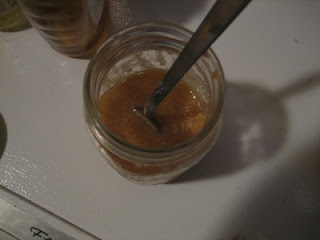Okay, so I'm finally getting around to my first recipe.
This is incredibly easy to make with a high pay-off. I serve it for my favorite friends and even dates so I have more time to shower or clean up my apartment while it's cooking.
It does use more pre-prepared ingredients than I usually use (one ingredient, really), but this particular star ingredient is so good, you'll hardly know it was this easy and cheap to make. My ambition here is to get those of you addicted to take-out, Rice-a-Roni, and SmartOnes weaned off of them, and the rest of you a little more time to do other things than cook but still have something tasty and healthy to eat.
Here's the star ingredient: Mae Ploy Curry Paste
Mae Ploy Curry PasteThis stuff is the best. You can use it in tons of things (more recipes later), it lasts forever, and
it's less than $2 at the Asian grocery store.
Mae Ploy curry paste comes in all kind of flavors, including red, green, Massman, and yellow.
I recommend starting out with the red or green. The red is the easiest to use with the most variety of ingredients. The green has a lighter, more fresh taste to it, but it's a lot spicier than the red. *I should note, though, that
if you're strictly vegetarian OR allergic to shellfish, the only flavor that doesn't have shrimp paste in it is the
yellow curry.
 The other flavors you need are:
The other flavors you need are:*
A can of coconut milk (~14 oz. and don't get the wimpy light kind either -- I know we're trying to be healthy here, but it's not like we're going crazzzy having coconut milk. Whole foods, as research seems to show more and more these days, tends to be better for us than adulterated ones anyway. So live a little.)
*
Some kind of onion. You want about 1/2 to 2/3 cup. In order of most preferred to least are:
- green onions (p.s. you can save the green tops and sprinkle over your finished dish to serve)
- scallions
- yellow onions
- red onions
(any onion-ey thing will work, though; except no Funyuns -- don't be a jerk)
*
Mild vinegarApple Cider vinegar, rice vinegar, leftover white wine, or white wine vinegar
*
Soy sauce*
Lots of veggies, including, but not limited to:
Chinese eggplant, carrots, cauliflower, broccoli, peas, bell peppers... these can be frozen or fresh. When I make this in the winter, I often end up using those frozen vegetable mixes with cauliflower, broccoli and carrots.
*
Your preferred proteinWith the red or green curry, a mild, light fish like tilapia (or halibut or cod) is my favorite, but tofu or chicken are also good. Just keep in mind the chicken will need to be cut up smaller to make sure it cooks through.
Around 8 oz (~2 servings) is about right.
Beef or chicken would go best with the Massman curry
Chicken, beef, lamb, or some kind of bean or lentils would go best with the yellow curry
Directions:1.
Preheat your oven to 350.Take note: I try to get away with baking dishes whenever possible because I am lazy.
Baking is a lazy cook's secret. It's usually is easier than cooking things in a pan on the stove because instead of monitoring a pan on the stove, you can just put your pan of stuff in the oven and check on it every once in a while. It's like we're making a chic casserole in the 1950s, except it's actually not a casserole at all and we don't have to take the rollers out of our hair or shine the silverware while it's baking, we can read
Jezebel or
Harper's, or revisit our
favorite boy-band heartthrobs on YouTube, or have a kitchen
Bowie dance party instead.
2.
Lay your meat/tofu in the bottom of the pan.I'm using a cast iron skillet here, but any baking dish or pan will do. I would recommend lining anything that's not non-stick or glass with something, though, because the coconut milk will carmelize a little on the edges and be hard to scrub off later.
If you're using fish, lay it gently in the bottom of your baking dish or pan.
If you're using chicken, cut it into small pieces and lay them at the bottom of the pan. Ditto for tofu.3.
Slice up your onions and sprinkle them over the fish/chicken/tofu.I used some kind of monster green onion/leek I found at the Asian grocery store here. I'm not using any kind of protein because I'm having leftover Vietnamese meatballs on the side, but you can imagine...
4.
Cut your veggies into chunks (or cut open your bag of frozen veggies) and layer them over your fish/chicken/tofu.Here I used what I had in my fridge and freezer: fresh carrots, Chinese eggplant (the
long skinny ones you usually just find at the Asian grocer or farmers market; don't use the
big fat European ones -- they will taste weird), and frozen broccoli.

5.
Scoop about 2-3 heaping tablespoons of the curry paste into a bowl and add a little of the coconut milk to break up the paste (this will make it easier to mix it into the rest of the milk), mix it together with a fork until it's smooth and well blended.
Then, pour in the rest of the coconut milk and blend it well.
6.
Pour the coconut milk/curry mixture over your pan of veggies and meat/tofu as evenly as possible (don't go crazy over this, you'll mix it up again later). It's okay that not everything's immersed.

7.
Sprinkle a little (about 1-2 tablespoons) of soy sauce and then vinegar over the top of it all.
8.
Pop it in the oven 20-35 minutes or until the veggies have softened and the meat is cooked through.
9. Dump some
rice and water in your rice cooker and start it (or make it on the stove if you don't have a rice cooker). If you're not familiar with making rice, the basic steps are this: measure one part rice, one-and-a-half parts water into a pan; bring to a boil, reduce to the smallest simmer possible and cover with a lid; cook until all water is absorbed -- about 15 minutes for white rice, 30 minutes for brown.
By the time your rice is done cooking and rested for a bit, your curry will be ready.
10. While all that's cooking, you'll have plenty of time to read the news, call your mom, or watch some cat videos on YouTube, AND still make
this miso dressing to put on your salads for lunch tomorrow and for the next month.
11.
Take your curry out of the oven and mix it up to distribute the sauce (if you're doing fish, take the fillets of fish out and set them aside first so you don't mash them up).
Serve over a bed of rice.
12.
Enjoy and gloat over how clever your are for making something so good and healthy for so little effort.


















